This is an installation write-up and product review on the Bulldog 10K pound winch. I’ve included “product review” since I really wasn’t looking for a new winch when I came across this one. A friend of mine wanted to know what I thought about this winch and so I agreed to evaluate one. I don’t claim to be a recovery guru but I’ve hung on the end of my winch a few times and have assisted in a few vehicle recoveries. I’ll do the best I can with this evaluation, good or bad, and let you all know what I think.
This model Bulldog is not priced as high as a similar sized/rated Warn nor is it at the basement pricing that you see for some brands. Line speed, grunt power, motor heat up, were pretty much unknowns except for the manual which provides line speed numbers. The fit and finish seem to be quite good. I found that the effect of having it in front of the radiator seems to be no worse than my previous Warn and might even be a little bit better. My tranny ran a little cooler coming home the other day even though ambient air temps should have seen it running a little bit higher on the tranny temp gauge. I’m just guessing here but perhaps the profile of the winch causes less air flow deflection to my slightly undersized tranny cooler that is mounted in my grill.
The owner’s manual indicates the 5.8 HP motor along with the 265:1 gear reduction will yield loaded line speed numbers that are slightly better than my Warn XD9000i…..however, they are so close that I’m not sure I could measure them accurately enough in the field to tell the difference. With the higher gear reduction, the current draw on the motor is down a fair amount. Going by the printed specs for both winches, my Warn pulls 415 amps for an 8K pound pull. The Bulldog manuals shows the same pull at only 310 amps. I have access to a high current amp meter and will get some measurements when I get the chance. If the lower numbers are true, the battery an alternator will appreciate it. A 2K pound pull (probably more realistic for the things that I do here in Arizona) has the Warn at 180 amps and the Bulldog pulling 120 amps….again, this is an appreciable difference and the line speeds are within 6″ of each other for a 1 minute pull.
So…..my Warn XD9000i came off and I installed the Bulldog. Why? I had the opportunity to test a new product and maybe find a reasonably priced winch that provides the reliability we all want at a price that more folks can afford. Also, I’ve been known to make comments that are not all that flattering in regards to non-Warn winches. I’ll admit that this is the first non-Warn winch that I’ve personally seen that left me with a favorable first impression. Time will tell how it does in the long haul and I can’t report on that until the time has passed and I’ve used it. I’ll be giving it an initial workout to see just how accurate the line speeds are and get some first hand experience with it once the cable has been stretched and re-spooled. While I was going to install my Amsteel blue synthetic winch line right away, I decided that the winch should be tested in its current shipping configuration. Later on, I’ll put the synthetic line on it.
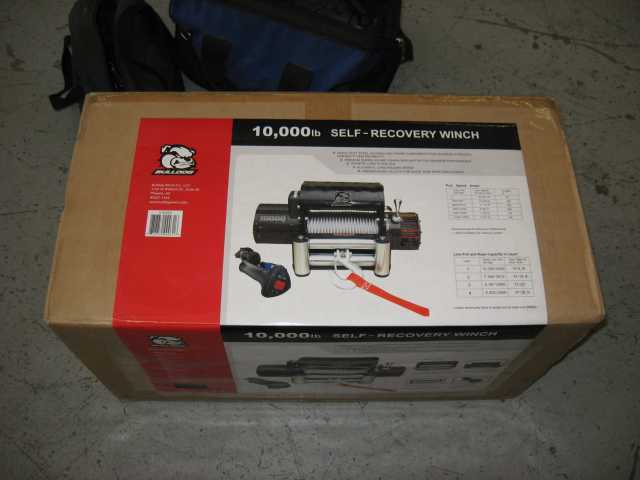
At least the Bulldog doesn’t come in a plain brown box. It’s labeled with line speed specs and other misc data that one might typically find on a winch box. The winch weighs in at 88 pounds and as I was carrying the box to my TJ, I honestly didn’t doubt that number for a second.
OK…..so let’s see what comes in the box.
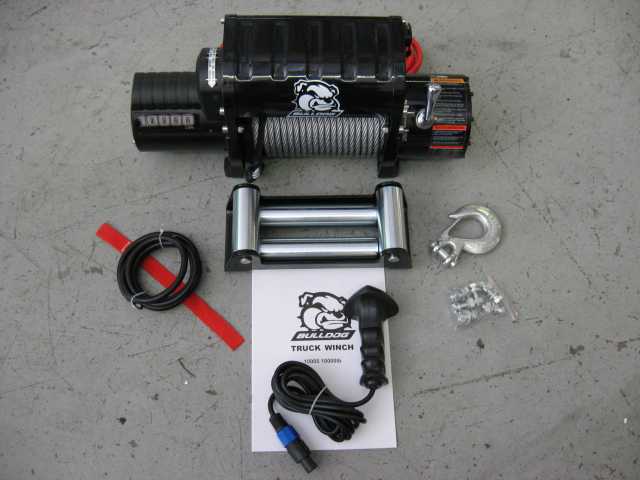
I found one winch with 87′ of .36″ cable. In case you were wondering, 3/8″ cable is .375″ diameter. My Warn 9K winch came with 5/16″ cable which is .3125″ diameter. For comparison, the 12K Warn winch uses 3/8″ cable. It would seem that the Bulldog steel cable is more than adequately sized for the 10K pound rating.
The winch’s positive battery cable is already attached while the supplied ground cable will be attached by you. A winch hook is included along with mounting hardware. The mounting hardware is for mounting the winch to your winch plate and also to mount the roller fairlead to your winch plate. A red hook safety strap and a cabled remote (12 foot long) rounds out the pieces and parts collection. An owners manual which includes specs, a lot of safety information, and exploded parts diagram adequately qualifies as documentation (it was nice to see a printed manual versus a photo copied reproduction).
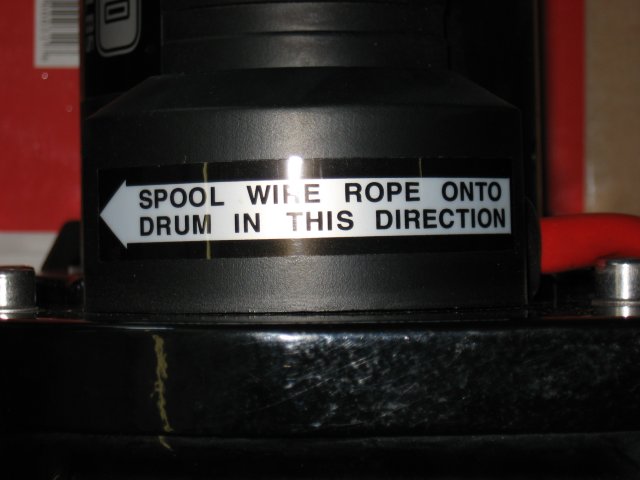
I had to snap this photo after I saw this on the winch. A local Jeeper recently had a synthetic winch line failure due to the cable being spooled incorrectly onto the drum. When I saw this, I immediately thought of his situation and was pleased to see this on the Bulldog.

The gearbox houses the clutch shifter. With it, you can free spool cable off of the winch drum (OUT position) and power it back in (IN position).

Before mounting the winch on the TJ, I removed the bolt on the bottom of the motor and attached the ground cable to the winch housing.
Bulldog 10K lb. Winch

First thing to come off the TJ was my bumper. Most are held on with 3 bolts going into each frame rail…..two on top, one on the bottom. One of the lower Torx bolts is being removed in this photo. Note the anti-seize on the threads. Even though Arizona is not much in the way of rusting, it takes so little effort to put a bit of anti-seize on the threads during reassembly. I enjoy not fighting with rusted mounting hardware.
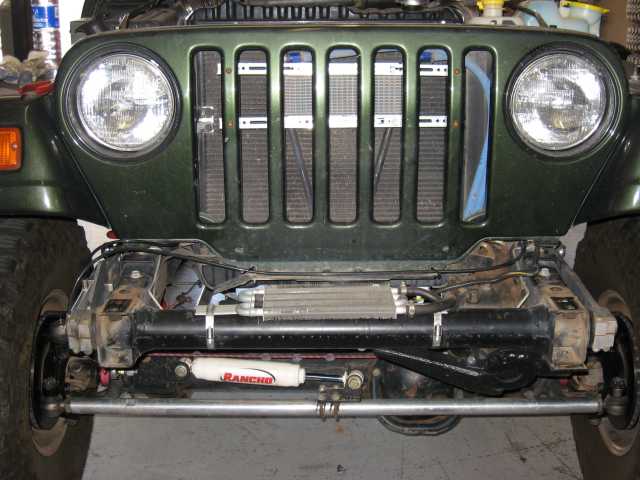
You know, the front of a TJ looks kind of ugly once you strip the bumper off. You can see my power steering cooler attached to the cross member.
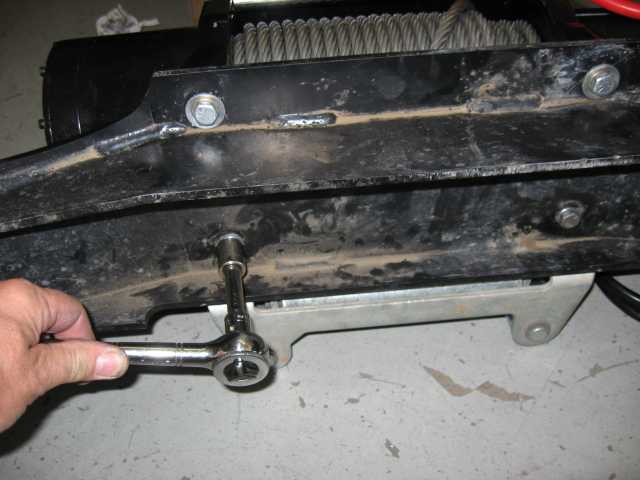
I used the same winch mounting plate I had on the Warn winch and so excuse the dirt/dust as it is far from new. The winch has the same mounting footprint as did my XD9000i. The only difference was that the supplied mounting bolts were metric. The holes in my plate were just a bit too small for the metric hardware so I opted to use the hardware I removed when the Warn came off the mounting plate. Four bolts attach the winch body to the mounting plate. You may have to grab a drill bit and take them up to the next size for the slightly larger supplied mounting bolts.
I also opted to leave the roller fairlead on my winch plate. Since it had been previously used with steel cable and the Bulldog roller fairlead was untouched, I decided it would do just fine with more steel cable. Looking at the two roller fairleads, I could detect no notable difference between the two. While possible, I doubt my substituting one for the other will influence the winch’s performance results.
I slipped the cable through the fairlead opening and attached the hook to the cable. I persuaded a friend to help me lift the winch and mounting plate back onto the TJ to help avoid bending the fins on my power steering cooler.
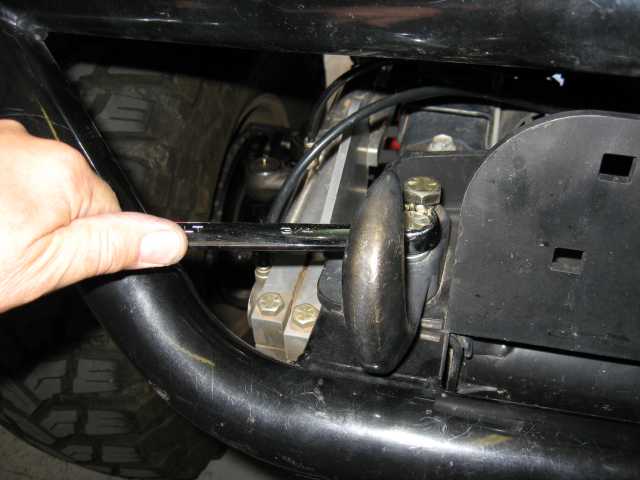
With the winch secured to the mounting plate and sitting on the frame rails, I put the bumper back into position and proceeded to tighten both to the frame rails. The tow hook bolts (longer than stock) secure the tow hooks and mounting plate to the top of the frame rails.
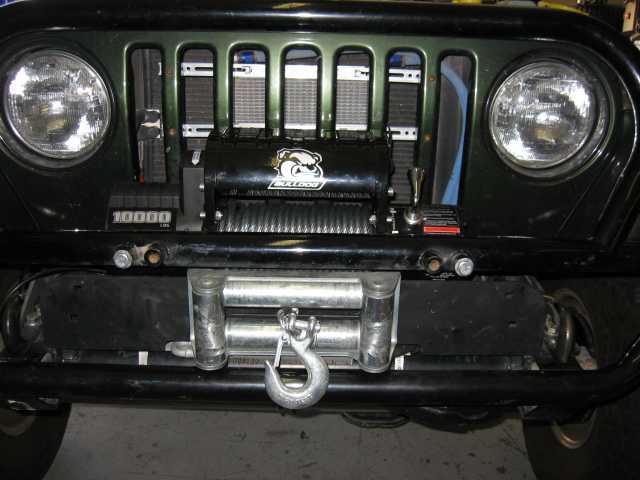
That took care of getting the Bulldog 10K winch on the front of the TJ. I routed the cables through a small opening along the passenger side of the grill and into the engine compartment. The cables are then brought up and zip tied to the grill support rod. They follow the rod and terminate at the battery. I connected them to the top posts of my Yellow Top battery since the side posts are not designed to source the current load generated during heavy winch operation. (so states an e-mail from Optima customer service)
Bulldog 10K lb. Winch
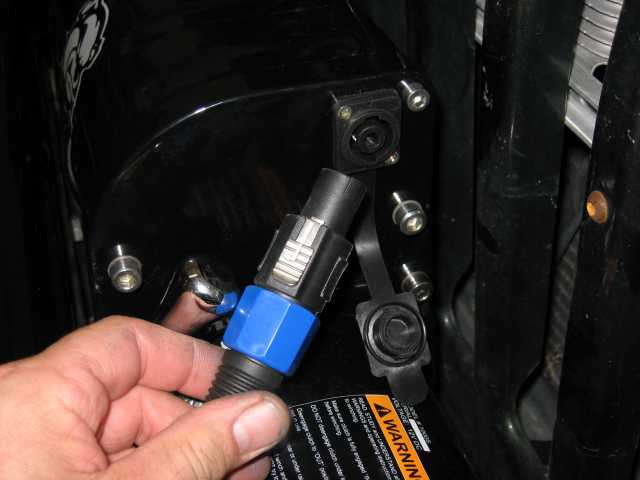
With the battery connections made, it was time to test the winch. The plug on the end of the remote cable was different than what I was use to. That’s not a bad thing, just a different thing.
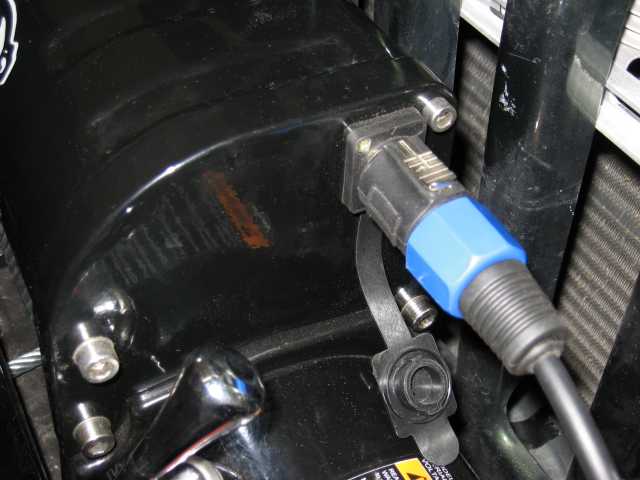
The connector plug is keyed and so only engages the socket on the winch housing one way…..trial and error proved to me. If you insert the plug into the socket and rotat it clockwise about 1/8 of a turn, you will hear it click/lock into position. The plug is removed by sliding the small metal locking tab and rotating the plug about 1/8 turn counter-clockwise. (there is a little arrow on the lock that shows which way it slides) It is more difficult describing it than it is actually doing it.
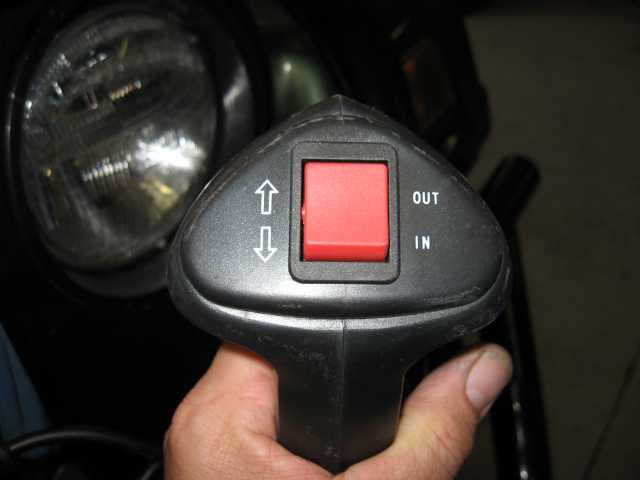
Here is the business end of the winch controller. Personally, I appreciate the OUT and IN on the controller. I realize that the Warn controller uses the little icons to indicate which way the cable is going and that does make for a very universal control and is not language dependent. However, I always have to stop and look at them (with my aging eyes) to see which way I want to move the switch. I can read this one just fine without squinting! Besides that, I’ll most likely not have that many non-English reading spotters using my winch remote. If I do, I’m confident that sign language and the arrows will accomplish the task.
I picked up the phone today and called the Phoenix, AZ phone number that was on the owner’s manual. I ended up spending about 15 minutes speaking with Bob, who I believe is THE main Bulldog at the office…..at least, that was the impression I got. On a more serious note, I found Bob to be an enthusiastic person who was pretty passionate about his business. I passed along some feedback and got to ask a few questions.
Question #1: Can the winch remote connector or the connector with some attached cable be purchased? The answer was yes, that could be arranged. I explained that myself, and others, often time like to wire an in-cab controller. By using the factory connector at the winch, it can be easily unplugged and the regular controller plugged in when needed. That lead to some discussion about in-cab controllers, etc.
Question #2: Have you considered using SAE hardware versus the metric mounting hardware. The answer was yes, it was considered and no, the metric will continue to be shipped. Bob felt the slightly larger metric hardware was a good thing and has found from personal experience that many brands of mounting plates handle his hardware without issue. He mentioned that his recent trip to Moab for the 2007 Easter Jeep Safari found him selling a winch to a person who had for certain a Warn manufactured winch mounting plate. Those holes were just slightly undersized (as were mine) for the Bulldog mounting hardware.
We discussed synthetic line, tree savers, and a few other topics before the conversation was ended. Since Bulldog is a local Phoenix company, I believe I’ll have to stop by and pay Bob a visit in person. I heard he has a killer 3K winch that works well as a TJ suspension suck down winch.
That is about it for now……not much else I can say until I get out to the trail and pull some cable to see how it works. As I said, I’ll be reporting back what I discover. Bob insisted that I let him know how it performed and to let him know if there were any issues, areas for improvement, etc. As I said earlier, he is serious about his company and I’ve no doubt he means to improve his product line where ever he can.
Bulldog 10K lb. Winch
Update 05/14/2007:
A friend of mine named Bob, and I, stole Troy’s TJ to use as a winch point for today’s Bulldog 10K winch evaluation. Before we got started, I first tensioned/stretched the wire rope onto the winch drum. Bob applied some brake pedal on my TJ while I ran the controller and ensured the wire rope wound correctly onto the drum. The owner’s manual states a load of about 500 pounds. I’m not certain just what the load was….but given the tension of the cable, I’m confident we had a sufficient load to cause some stretching.
With the tensioning out of the way, I went to the bottom of the wash and we lined up the vehicles for a straight pull up the side of the wash. The bank is about 50′ long and is “surfaced” with a sprayed on concrete mixture to keep erosion to a minimum. We positioned Troy’s TJ so that I had the first layer on the drum completely filled with wire rope when I started the trip up the bank. We attached a mechanical clamp-on ammeter to the + winch cable….the ammeter reads 0-600 amps and we expected most of our readings to be in the middle portion of the scale.
I was going to time the event to see how long it took us to get to the top of the bank, but part way into the pull, I opted to stop and let the battery recover a bit. I did this a couple of times. As much as I appreciate what an Optima Yellow Top battery is built to do, I couldn’t see sucking it down all the way for this evaluation. I was monitoring the voltmeter on the instrument cluster while Bob kept an eye on the ammeter.
I used no driveline assistance when going up the bank. I kept the motor at about 2000 RPM so as to coax some help from the alternator…..not unlike what I might do on the trail during a winching session.
Once I had all 4 tires on the bank itself, Bob checked the amp draw….about 150 amps. It jumped up to about 200~225 when the 2nd layer filled and the wire rope transitioned to the 3rd layer. Near the top of the bank, with the wire rope moving onto the 4th layer, we pulled a solid 300 amps.
At no time did Bob or I notice any kind of change in the pulling power…..it remained a smooth and steady pull except for the times I stopped and let the battery rest for a minute. Once we crested the top with the front tires, line speed began picking up steadily while the amp load fell off (not unexpected). Once all 4 tires were off the bank and the vehicle once again level, it took about 50 amps to pull the vehicle.
I did two things during this evaluation that I would not usually do on the trail. I never winch with my tranny in neutral…..I always am assisting the winch with power from the drive train. Today’s test put much more strain on the components than I would normally cause to happen under normal trail use. I also do not winch the extended periods as I did today. I didn’t bring an IR thermometer so I can’t tell you how hot the motor got….it was certainly hot to the touch at the end of the pull and you weren’t going to keep your fingers on it. However, I did stick my nose down next to it to see if the faint odor of hot motor windings was present….it was not. I’ve smelled a hot winch motor on the trail before and didn’t find it on today’s evaluation. So that too is a good thing.
One thing I noticed was that the line speed appeared to be slower than what I expected. I am not saying this a bad or good thing. My personal preference…I like to winch with a slower line speed. As I mentioned, this was a dead pull test….no assistance was coming from the tires. I’m not use to winching in this fashion and so this would cause the line speed to be slower than what I am use to seeing from the driver’s seat.
First impressions? I was very satisfied with the winch’s performance. I am not a winch expert….never was, never will be. I’m relying on my previous experience with my Warn winch as a bench mark for today’s evaluation. In my opinion, the Bulldog winch performed well and didn’t leave me wanting for anything. OK, I confess….I’m still not in love with the shape of the winch controller, but I’ve been told that is being changed. In the grand scheme of things, the controller’s shape is minor.
I’ll report again once I get a chance to hang on the end of the cable on a waterfall (or something equally fun). In the mean time, my almost new Amsteel blue synthetic winch line will be going on the Bulldog. I think the blue line will contrast nicely with the black winch color. (The previous statement was made for those that have higher levels of “Does this blue line make my winch look good?” than I do.)
Update 06/02/2007:
I decided to install Amsteel Blue synthetic winch line onto the Bulldog. (yeah, that does seem to indicate I am going to be keeping it on the TJ)
The Bulldog uses the same method of attaching the line to the drum as do most winches…..a screw holds the crimped on connector to drum. The screw used in the Bulldog is metric which is no big deal. However, the attachment connector supplied by Winchline.com for their Amsteel Blue line was to big for the Bulldog screw. With the Bulldog screw in hand, I made a quick trip to the local ACE Hardware store (they have, hands down, the best fastener selection of any chain store around). The metric screw is a M6x1.0 (size and thread pitch) and one about 12mm long worked just right for me. Depending on the type of attachment connector your line has, a different length may be required.
Once home, I attached the Amsteel Blue to the winch drum and spooled the line into place. The 100′ of Amsteel Blue I used had no issues fitting on the drum.
